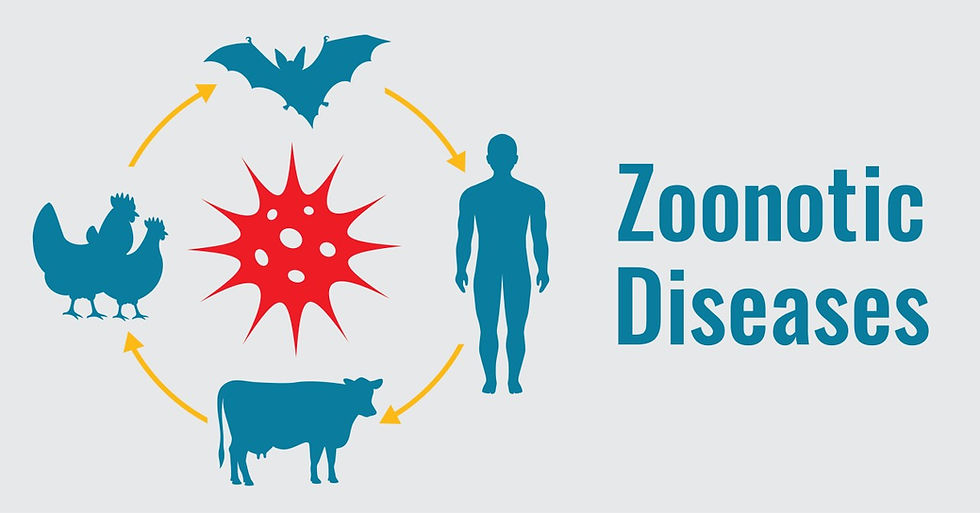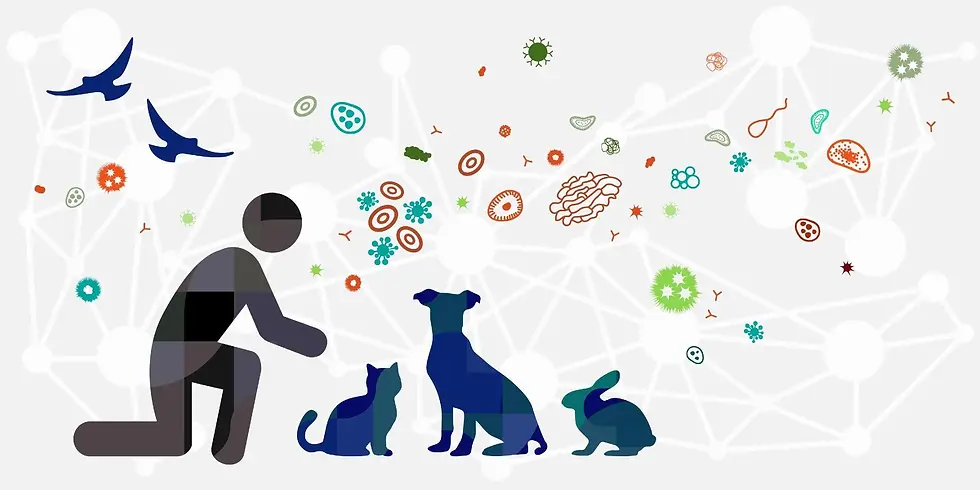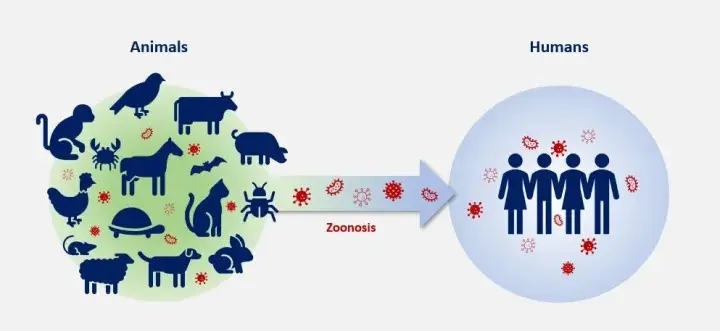Emerging Zoonotic Diseases: The Next Pandemic Risk?
- Shreya Giri
- Sep 22, 2025
- 4 min read
Human history is deeply intertwined with disease. For centuries, epidemics have reshaped societies, influenced economies, and altered the course of civilizations. A recurring theme in many of these outbreaks is the role of zoonotic diseases, infections that originate in animals but spread to humans. The COVID-19 pandemic demonstrated how a zoonotic disease can paralyze the world within weeks, but it was not the first and certainly will not be the last. Today, with globalization, deforestation, industrial farming, and climate change, the risk of zoonotic diseases is at an all-time high. This blog explores what zoonotic diseases are, how they emerge, historical and modern examples, their drivers, impacts, and what can be done to prevent the next outbreak.

The word zoonosis comes from the Greek words zoon (animal) and nosos (disease). The term refers to any infectious disease that spreads from animals to humans—either directly (through bites, saliva, blood, or other bodily fluids) or indirectly (through vectors like mosquitoes, ticks, or contaminated food and water).
The World Health Organization (WHO) estimates that about 60% of all human infectious diseases and over 75% of emerging diseases are zoonotic.
Types of Transmission
Direct Transmission – through contact with infected animals (e.g., rabies, ringworm).
Indirect Transmission – via contaminated surfaces, food, or water (e.g., salmonellosis).
Vector-borne Transmission – by insects such as mosquitoes and ticks (e.g., malaria, Lyme disease).
Airborne Transmission – pathogens inhaled after being released by animals (e.g., Q fever).
Zoonotic diseases are not new, they have shaped history for centuries:
The Plague (Black Death, 14th century): Spread from rodents via fleas, it killed up to 200 million people in Europe and Asia.
Spanish Flu (1918–1919): An avian-origin influenza virus that infected one-third of the global population and killed nearly 50 million.
HIV/AIDS (20th century): Believed to have originated from primates before spilling into humans, it remains one of the deadliest pandemics with over 40 million deaths.
Ebola (1976–present): Thought to originate from fruit bats, causing repeated outbreaks in Africa with mortality rates as high as 90%.
COVID-19 (2019–present): Suspected zoonotic origin, responsible for millions of deaths and global disruption.

Common Zoonotic Diseases
Let’s look at some important zoonotic diseases affecting humans today:
1. Rabies
This disease is caused by a virus that spreads through the bites of infected animals, most commonly dogs and bats. Once symptoms begin to appear, it is almost always fatal, making it one of the deadliest viral infections. However, it is entirely preventable if timely vaccination and post-exposure treatment are administered, highlighting the importance of rapid medical intervention.
2. Avian Influenza (Bird Flu)
Viruses such as H5N1 and H7N9 originate primarily in poultry and occasionally cross over to infect humans. While human cases are relatively rare, the infections are associated with very high mortality rates. Fortunately, sustained human-to-human transmission remains limited, but the potential for mutation and wider spread continues to pose a significant global health concern.
3. Swine Flu (H1N1)
This disease emerged in 2009 from pigs and quickly spread across the globe, infecting millions of people within a short period. Although it caused widespread concern and was initially feared to be highly deadly, it ultimately proved to be less lethal than expected, though its rapid transmission highlighted the vulnerability of global populations to new viral outbreaks.

4. Nipah Virus
This disease emerges from fruit bats and is transmitted to humans either through the consumption of fruit contaminated by the bats or through contact with animals such as pigs that act as intermediate hosts. It is considered highly dangerous, with a fatality rate that can reach up to 75%, making it a serious public health concern in affected regions.
5. Lyme Disease
This bacterial infection is transmitted through the bite of infected ticks. It is particularly common in North America and Europe, where cases frequently occur during the warmer months. If left untreated, the illness can lead to symptoms such as fever and fatigue, and in more severe cases, it may progress to cause neurological complications.
6. Brucellosis
It is commonly spread through the consumption of unpasteurized dairy products or direct contact with livestock. Once infected, individuals often experience chronic fever along with persistent joint pain, which can significantly impact their daily activities and overall quality of life.
Why Are Zoonotic Diseases Increasing?
Several modern factors accelerate the rise of zoonotic diseases:
1. Deforestation and Habitat Loss
As humans cut down forests for agriculture or urbanization, wildlife loses its natural habitat. This forces animals, bats, monkeys, rodents, closer to humans, increasing spillover risks.

2. Wildlife Trade and Wet Markets
Illegal wildlife trade and poorly regulated markets put humans in direct contact with exotic animals carrying unknown pathogens. SARS and possibly COVID-19 emerged under such conditions.
3. Industrial Farming
High-density livestock farming provides breeding grounds for pathogens. Viruses in poultry and pigs can mutate rapidly, creating strains capable of infecting humans.
4. Climate Change
Rising temperatures and shifting ecosystems expand the range of vectors like mosquitoes and ticks. Diseases like malaria, dengue, and Zika are appearing in new regions.
5. Global Travel and Trade
Modern transportation enables pathogens to spread across continents within hours. A local outbreak can escalate into a global crisis rapidly.
6. Population Growth and Urbanization
Crowded urban environments facilitate faster human-to-human transmission once a disease jumps from animals.

About the Author
Shreya Giri is a talented SEO content writer with a unique flair for captivating readers. With a bachelor's degree in geography, her passion for crafting exceptional content shines through in every word she writes. Shreya's expertise lies in her ability to seamlessly blend language and storytelling, effortlessly capturing the attention of her audience.
She is pursuing a Master's degree in geography and has a remarkable talent for transforming intricate concepts into captivating narratives that have a lasting impact. With Shreya, you can expect excellent, compelling content that will keep you engaged from beginning to end.
You can connect with her through-
My-Lekh profile- https://www.my-lekh.com/profile/shreyagiri3008/profile
LinkedIn profile- https://www.linkedin.com/in/shreya-giri-a0a607265
Email- shreyagiri3008@gmail.com





Comments